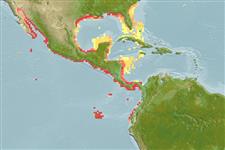Environment: milieu / climate zone / depth range / distribution range
Écologie
marin récifal; profondeur 3 - 30 m (Ref. 5227), usually 9 - 15 m (Ref. 5227). Tropical; 33°N - 3°S, 116°W - 77°W (Ref. 55)
Eastern Pacific: Mexico to Ecuador. Most common at offshore islands including Mapelo, Galapagos, Tres Marias and Revillagigedo.
Taille / Poids / Âge
Maturity: Lm ? range ? - ? cm
Max length : 30.0 cm TL mâle / non sexé; (Ref. 55)
Épines dorsales (Total): 10; Rayons mous dorsaux (Total): 14-15; Épines anales 3; Rayons mous anaux: 8. Preopercular notch and knob strong. Scale rows on back rising obliquely above lateral line. Generally bright yellow, with 5 black-edged bluish-white stripes on the sides; the belly whitish with narrow gray lines; the fins mainly yellow.
Adults are found in coastal waters, frequently around rocky and coral reefs (Ref. 9313). They occasionally occur in large schools (Ref. 9313). Also caught with nets and marketed fresh (Ref. 9313).
Life cycle and mating behavior
Maturité | Reproduction | Frai | Œufs | Fécondité | Larves
Allen, G.R., 1985. FAO Species Catalogue. Vol. 6. Snappers of the world. An annotated and illustrated catalogue of lutjanid species known to date. FAO Fish. Synop. 125(6):208 p. Rome: FAO. (Ref. 55)
Statut dans la liste rouge de l'IUCN (Ref. 130435)
Menace pour l'homme
Harmless
Utilisations par l'homme
Pêcheries: pêcheries vivrières
Plus d'informations
Noms communsSynonymesMétabolismePrédateursÉcotoxicologieReproductionMaturitéFraiRassemblement de ponteFéconditéŒufsDéveloppement de l'œuf
RéférencesAquacultureProfil d'aquacultureSouchesGénétiqueElectrophoresesHéritabilitéPathologiesTraitementNutrientsMass conversion
CollaborateursImagesStamps, Coins Misc.SonsCiguateraVitesseType de nageSurface branchialeOtolithesCerveauxVision
Outils
Articles particuliers
Télécharger en XML
Sources Internet
Estimates based on models
Preferred temperature (Ref.
123201): 23.2 - 28.9, mean 25.9 °C (based on 291 cells).
Phylogenetic diversity index (Ref.
82804): PD
50 = 0.5000 [Uniqueness, from 0.5 = low to 2.0 = high].
Bayesian length-weight: a=0.01479 (0.00706 - 0.03101), b=2.97 (2.81 - 3.13), in cm total length, based on LWR estimates for this Genus-body shape (Ref.
93245).
Niveau trophique (Ref.
69278): 4.2 ±0.74 se; based on food items.
Résilience (Ref.
120179): Milieu, temps minimum de doublement de population : 1,4 à 4,4 années (Preliminary K or Fecundity.).
Fishing Vulnerability (Ref.
59153): Low vulnerability (20 of 100).
Nutrients (Ref.
124155): Calcium = 49.1 [30.1, 79.1] mg/100g; Iron = 0.42 [0.27, 0.69] mg/100g; Protein = 18.5 [16.9, 19.8] %; Omega3 = 0.136 [0.089, 0.213] g/100g; Selenium = 45 [26, 77] μg/100g; VitaminA = 277 [53, 1,126] μg/100g; Zinc = 0.454 [0.338, 0.661] mg/100g (wet weight);
